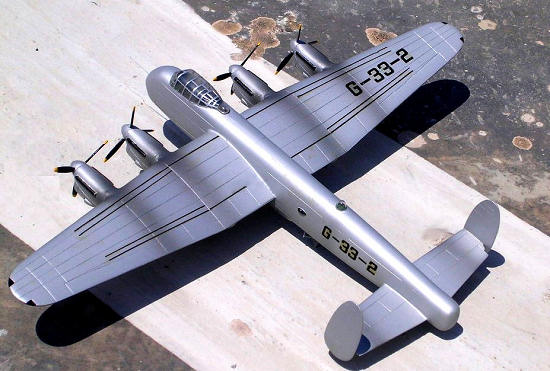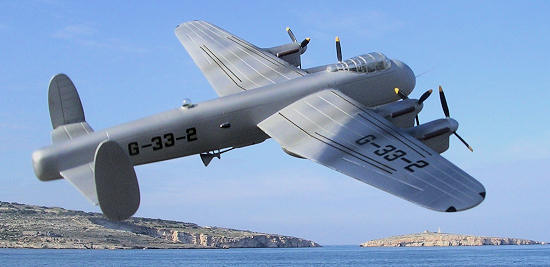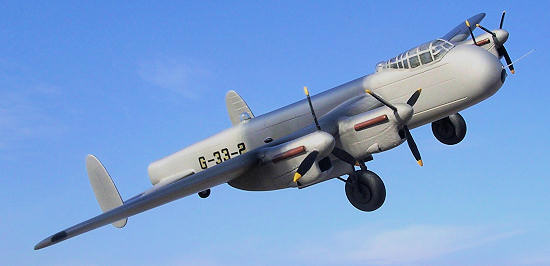Frog 1/96 Lancaster TK (conversion)

The
transformation of in-flight-refueling to a technique of practical use was
wrought by a single man, Sir Alan Cobham. From 1930 he studied the problem. He
talked with Flight Lieutenant R.L.R. Dick Atcherly, who had researched the
problem in the
USA,
drawn up a scheme for an improved system involving a weighted cable trailed from
a tanker and a grapnel fired from the receiver, and taken out a patent. In 1934
Cobham formed a company, Flight Refueling Ltd, to develop Atcherly’s system. His
two big HP W.10 were taken off National Aviation Day barnstorming and converted
as tankers to refuel the prototype Airspeed Courier G-ABXN. The latter took off
on
24th
September 1934
to fly to
India;
it refueled over the Isle of White, but over
Malta
a throttle breakage forced Cobham to make a wheels up landing. Undaunted, Cobham
forged on at Ford airfield, Sussex and gained Air Ministry support to carry out
trials with two Vickers Virginia bombers, the Armstrong Whitworth AW 23, Handley
Page HP 51, a Boulton
 Paul Overstrand and the Vickers B9/27. In 1937 hardware
was designed for refueling Short C-class flying boats to enable them to fly the
North
Atlantic,
trials being flown with a AW 23 and the boat
Cambria.
Against competition from Mayo Composite aircraft, which sought long range by
using a pick-a-back carrier aircraft.
Paul Overstrand and the Vickers B9/27. In 1937 hardware
was designed for refueling Short C-class flying boats to enable them to fly the
North
Atlantic,
trials being flown with a AW 23 and the boat
Cambria.
Against competition from Mayo Composite aircraft, which sought long range by
using a pick-a-back carrier aircraft.
Attempts to develop a technique with in mind that refueling could close the mid
Atlantic gap, where during the war years U-boats lurked beyond the RAF’s range
but little more was done. In 1944 the RAF realized it had nothing in the class
of the B-29, and that the planned Tiger Force to bomb
Japan
would be unable to fly useful missions. An answer was to burden the Avro
Lancaster with a vast 1,200 Imp gallons saddle tank but in-flight refueling
seemed a better solution. When the war ended in August 1945 the Flight refueling
design team at Ford came with a breakthrough which consisted of the probe/drogue
method whereby the tanker merely trails a hose with a stabilizing drogue on the
end which serves as a conical guide for a rigid forward-pointing pipe or drogue
leading into the fuel system of the receiver aircraft. The valves on the drogue
and probe are automatically opened when the two are locked together, and close
as soon as contact is broken.
Three ex-RAF
Lancaster
B Mk 3s were used: NE147, PB972 registered as Class B G-33-2 and ND648 (G-33-3).
The company itself purchased a further four aircraft, which were rebuilt at
Staverton as combined tanker/receivers and received civil registration: LL809,
LM681, LM639 and ED866 became G-AHJT/U/V/W respectively. The first two gave the
first public demonstration of loop-hose refueling at the 1946
SBAC
show. With the emergence of the Avro Tudor airliner, non-stop missions to
Bermuda
were  explored with a refueling near the
Azores,
and the first flight was made in 20 hours on
28th
May 1947
using two
Lancasters.
Another refueling took place on the return, made in 15 hours 30 minutes, but in
flight refueling was never used operationally in post-war civil aviation.
explored with a refueling near the
Azores,
and the first flight was made in 20 hours on
28th
May 1947
using two
Lancasters.
Another refueling took place on the return, made in 15 hours 30 minutes, but in
flight refueling was never used operationally in post-war civil aviation.
The subject of this kit build is Avro 683 Lancaster
III/I
serial PB972 that was used for the Refueling flight trials at Staverton in March
1945. The
Lancaster,
which is now registered G-33-2 was employed for one of the early development
probe-and-drogue refueling programmes. The shortened nose on the
Lancaster
was fitted as part of the development programme for civil use. This blunt nosed
Lancaster G-33-2 was the tanker and Meteor F Mk3 EE397 was the receiver. Most of
the hook-ups being over Bournmouth/Poole area,
UK,
and in the accompanying photo taken on 7th of August 1949 it is in
company of Lancastrian believed to have carried BSAA observers.
The
kit was in shops back in1966, molded in black styrene and clear transparencies
to be built as the type in service with RAF Bomber Command.
This was in fact a re-build project after encountering an interesting article on
the development of the Flight Refueling Programme conducted at Staverton circa
1945.
 This
was a straight from the box kit build as a first stage but with the cockpit
canopy left out for a later stage. The kit was then modified to the
flight-refueling configuration. Careful side drawings were studied of the type
to figure out the shape of modified nose that the particular
Lancaster
carried. The nose turret was carefully cut with a razor saw and a new one built
after a blanking piece made from plastic card closed the front section. The nose
was built in putty over a center section piece that had the final shape
required. Upper and rear turrets were faired over using Plasto as filler.
Fuselage side blisters and an astrodome were cut and the Perspex molded from
clear acetate after carving a male pattern in wood. Refueling equipment was
scratch built in scrap plastic and stretch sprue was then fitted under the
fuselage making reference to photos of the aircraft. Detail was added to the
cockpit and after painting the interior the canopy was glued in place. A long
antenna made from a length of steel wire was added to the nose.
This
was a straight from the box kit build as a first stage but with the cockpit
canopy left out for a later stage. The kit was then modified to the
flight-refueling configuration. Careful side drawings were studied of the type
to figure out the shape of modified nose that the particular
Lancaster
carried. The nose turret was carefully cut with a razor saw and a new one built
after a blanking piece made from plastic card closed the front section. The nose
was built in putty over a center section piece that had the final shape
required. Upper and rear turrets were faired over using Plasto as filler.
Fuselage side blisters and an astrodome were cut and the Perspex molded from
clear acetate after carving a male pattern in wood. Refueling equipment was
scratch built in scrap plastic and stretch sprue was then fitted under the
fuselage making reference to photos of the aircraft. Detail was added to the
cockpit and after painting the interior the canopy was glued in place. A long
antenna made from a length of steel wire was added to the nose.
The finished model was given an overall coat of silver mixed with
gloss varnish. Decals came from spares box making use of stripes from an Almark
sheet to mark the over wing black walkway stripes. Registration came from
spares.
 I enjoyed this mini project apart from minor annoyances such as
deep panel lines on plastic surfaces but considering the time when the kit was
first issued this could be tolerated. The finished model fully captures the
unusual subject and made me aware of the various experiments and trials that
underwent before the refined refueling system employed by so many air forces
today came into being.
I enjoyed this mini project apart from minor annoyances such as
deep panel lines on plastic surfaces but considering the time when the kit was
first issued this could be tolerated. The finished model fully captures the
unusual subject and made me aware of the various experiments and trials that
underwent before the refined refueling system employed by so many air forces
today came into being.
Carmel
J. Attard
November 2009
Copyright ModelingMadness.com. All rights reserved. No reproduction in part or in whole without express permission from the editor.
If you would like your product reviewed fairly and quickly, please
contact
the editor or see other details in the
Note to
Contributors.
Back to the Main Page
Back to the Review
Index Page 2023


 Paul Overstrand and the Vickers B9/27. In 1937 hardware
was designed for refueling Short C-class flying boats to enable them to fly the
Paul Overstrand and the Vickers B9/27. In 1937 hardware
was designed for refueling Short C-class flying boats to enable them to fly the
 explored with a refueling near the
explored with a refueling near the  This
was a straight from the box kit build as a first stage but with the cockpit
canopy left out for a later stage. The kit was then modified to the
flight-refueling configuration. Careful side drawings were studied of the type
to figure out the shape of modified nose that the particular
This
was a straight from the box kit build as a first stage but with the cockpit
canopy left out for a later stage. The kit was then modified to the
flight-refueling configuration. Careful side drawings were studied of the type
to figure out the shape of modified nose that the particular 